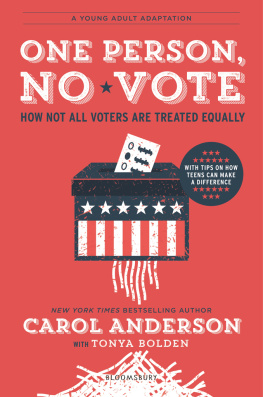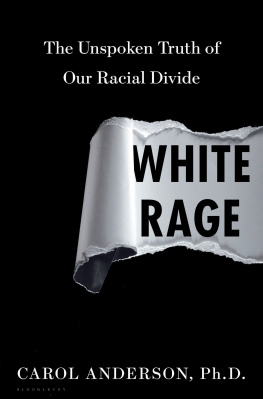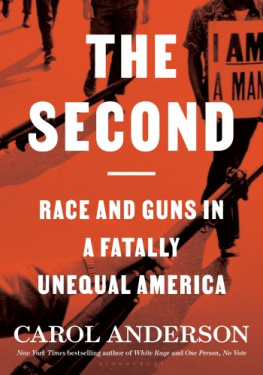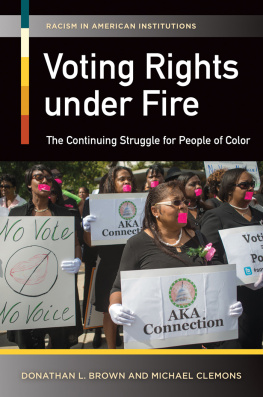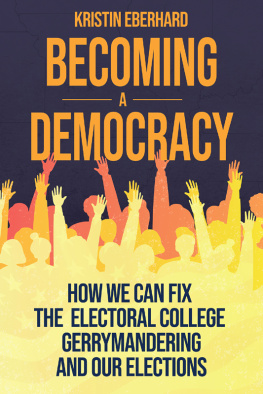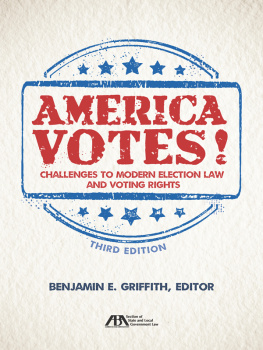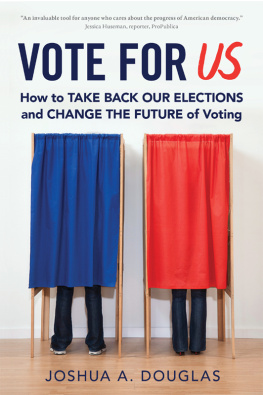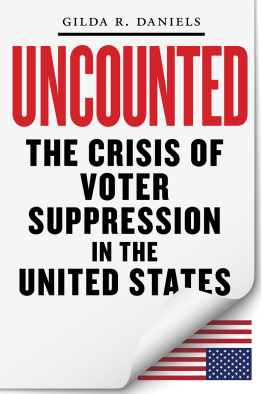Also by Carol Anderson with Tonya Bolden
We Are Not Yet Equal: Understanding Our Racial Divide

BLOOMSBURY YA
Bloomsbury Publishing Inc., part of Bloomsbury Publishing Plc
1385 Broadway, New York, NY 10018
This electronic edition published in 2019 by Bloomsbury Publishing Plc
BLOOMSBURY and the Diana logo are trademarks of Bloomsbury Publishing Plc
First published in the United States of America in September 2019 by Bloomsbury YA
Copyright 2019 by Carol Anderson
One Person, No Vote: How Not All Voters Are Treated Equally is a young adult adaptation of One Person, No Vote: How Voter Suppression Is Destroying Our Democracy by Carol Anderson, first published in 2018 by Bloomsbury USA
Bloomsbury Publishing Plc does not have any control over, or responsibility for, any third-party websites referred to or in this book. All internet addresses given in this book were correct at the time of going to press. The author and publisher regret any inconvenience caused if addresses have changed or sites have ceased to exist, but can accept no responsibility for any such changes.
All rights reserved
You may not copy, distribute, transmit, reproduce or otherwise make available this publication (or any part of it) in any form, or by any means (including without limitation electronic, digital, optical, mechanical, photocopying, printing, recording or otherwise), without the prior written permission of the publisher. Any person who does any unauthorised act in relation to this publication may be liable to criminal prosecution and civil claims for damages.
Bloomsbury books may be purchased for business or promotional use. For information on bulk purchases please contact Macmillan Corporate and Premium Sales Department at
Library of Congress Cataloging-in-Publication Data available upon request
ISBN: 978-1-6811-9756-2 (HB)
ISBN: 978-1-5476-0153-0 (eBook)
Book design by Kate Gartner
To find out more about our authors and their books please visit www.bloomsbury.com where you will find extracts, author interviews and details of forthcoming events, and to be the first to hear about latest releases and special offers, sign up for our newsletters.
To all of the voting rights warriors and activists who have fought and continue to fight to protect Democracy
CONTENTS
ONE PERSON,
NO VOTE
PROLOGUE
HMM...
It was a mystery worthy of master crime writer Raymond Chandler.
And the mystery was this: On November 8, 2016, black Americans did not show up at the polls.
It was like a day of absence.
Of a mostly black district in Milwaukee, Wisconsin, one reporter was told that folks there had virtually boycotted the election because they simply saw no affirmative reason to vote for Hillary. Some saw her as corrupt; others noted that they had not seen their economic situation improved during the Obama years.
Another journalist concluded that because Hillary Clinton lacked the ability, charisma, or magic to keep Barack Obamas coalition together, African-American, Latino and younger voters failed to show up at the polls in sufficient numbers. As proof of black peoples coolness toward Hillary Clinton, journalists pointed to the much greater turnout for Barack Obama in 2008 and 2012.
Yes, nationwide black voter turnout had dropped by nearly 17 percent. Whats more, less than half of Latino and Asian American voters went to the polls. The tide of black, Latino, and Asian American voters that had carried Obama into the White House in 2008 and kept him there for a second term had visibly ebbed.
But, you see, blacks, Latinos, and Asian Americans did not simply refuse to vote. Republican legislatures and governors had systematically blocked millions from the polls.
Why?
To survive.
The GOPs overwhelmingly white constituency was becoming an ever smaller share of the voting public and the party wasnt attracting legions of people of color because of its inability to craft policies that speak to an increasingly diverse nation.
Rather than reformchange its ways, its outlookthe GOP decided to disenfranchiseto deprive Democrat-leaning people of their right to vote.
One Person, No Vote is the story of these desperate, dastardly, and most undemocratic measuresand the history behind them.
PART ONE
A HISTORY OF DISENFRANCHISEMENT

After Reconstruction, some black Americans obtained positions in the government. But their power soon dwindled as white Americans worked against them.
BUBBLES IN A BAR OF SOAP
THE MILLIONS OF VOTES AND VOTERS THAT DISAPPEARED in 2016 were a long time in the making.
The drive to disenfranchise black people, in particular, is best understood by going back to strides toward a real democracy. A government, as Abraham Lincoln said in his Gettysburg Address, of the people, by the people, for the people.
This moment came after the Civil War, during Reconstruction. It brought, among other things, the 1865 Thirteenth Amendment to the US Constitution (slavery abolished), the 1868 Fourteenth Amendment (black citizenship cemented), and the 1870 Fifteenth Amendment (black men gained the national vote).
But a more democratic America was anathema to a multitude of white people.
Reconstruction, which ended in 1877, saw scores of black men in the political arena and in government. Black artisans and entrepreneurs, laborers and lawyers, mechanics and ministers became postmasters, sheriffs, marshals, councilmen, commissioners, state legislators, secretaries of state. A handful were lieutenant governors. More than a dozen served in the US Congress.
And so many did so much good. For example, one black South Carolina legislator remarked, black men helped to craft the laws relative to finance, the building of penal and charitable institutions, and, greatest of all, the establishment of the public school system. Yet the myth of incompetent, disastrous so-called black rule dominated. Said one newspaper editor in the early 1870s: No negro is fit to make laws for white people.
Many Texans refused to accept the fact that the Negro was free and equal, and stopped at nothing to prevent him from enjoying civic and political rights.
Maud Cuney Hare in her biography of her father, Norris Wright Cuney, a leading black Lone Star State activist, entrepreneur, and politician during Reconstruction
After Reconstruction, legions of white people did their utmost to ensure white ruleto keep black men from voting, to prevent black America from having any real political power. (While some black men did hold political office after Reconstruction, the numbers dwindled and dwindled.)
Black voter suppression really ramped up in 1890 when the Magnolia State passed what became known as the Mississippi Plan: a dizzying array of poll taxes; literacy tests; understanding clauses (which officials used to justify registering some white illiterate people who they claimed understood the information read to them); newfangled voter registration rules; and good character clauses. All were racially discriminatory, but they were pitched as simply a way to bring integrity to the polls.
Virginia state senator Carter Glass, like many other white politicians, swooned at the thought of bringing the Mississippi Plan to his state. During Virginias 19012 state constitutional convention, Glass championed a plan that would eliminate the darkey as a political factor in this state in less than five years.

